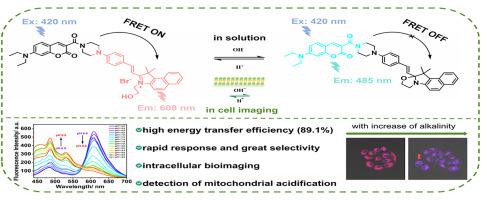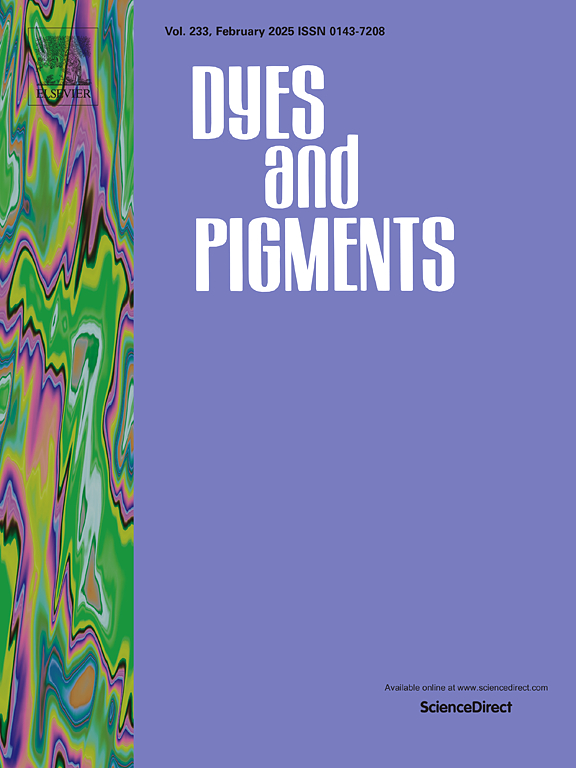A ratiometric fluorescent probe based on FRET mechanism for pH and its cell imaging
IF 4.1
3区 工程技术
Q2 CHEMISTRY, APPLIED
引用次数: 0
Abstract
pH balance is a prerequisite for maintaining cell function optimally and performs an important role in diverse physiological activities. Even subtle changes in cellular pH can influence many cell behaviors. More specifically, for mitochondria, its unique functions under physiological conditions depend largely on its pH values. Therefore, an effective analytical method needs to be developed to detect the alteration of intracellular pH values, especial in mitochondria. In this work, a ratiometric pH fluorescent probe (DPM) based on fluorescence resonance energy transfer (FRET) mechanism was developed by constructing coumarin and hemicyanine fluorophore. DPM could respond to pH changes by the FRET-off and FRET-on process depending on the cyclization and ring-opening reaction. DPM exhibited high energy transfer efficiency (89.1 %) and responded to pH ranges of 6.0–8.0 rapidly and selectively (pKa value of 7.6 in solution and 7.0 in cells). Moreover, DPM exhibited nearly non-toxicity to living cells and excellent photostability. DPM showed great pH-responsive feature in cells and achieved detection of mitochondrial acidification. The present work not only provided a new structure for pH fluorescence probe and simple synthetic method for the FRET-based probe but also found that the probe could target mitochondria in living cells.

基于 FRET 机制的 pH 值及其细胞成像比率荧光探针
pH 值平衡是维持细胞最佳功能的先决条件,在各种生理活动中发挥着重要作用。即使细胞 pH 值发生微妙变化,也会影响细胞的许多行为。更具体地说,线粒体在生理条件下的独特功能在很大程度上取决于其 pH 值。因此,需要开发一种有效的分析方法来检测细胞内 pH 值的变化,尤其是线粒体内 pH 值的变化。在这项工作中,通过构建香豆素和半氰基荧光团,开发了一种基于荧光共振能量转移(FRET)机制的比率计 pH 荧光探针(DPM)。根据环化和开环反应的不同,DPM 可通过 FRET-off 和 FRET-on 过程对 pH 变化做出响应。DPM 表现出很高的能量传递效率(89.1%),并对 6.0-8.0 的 pH 范围做出快速和选择性的反应(溶液中的 pKa 值为 7.6,细胞中为 7.0)。此外,DPM 对活细胞几乎无毒,而且具有极佳的光稳定性。DPM 在细胞中表现出极强的 pH 响应特性,可实现线粒体酸化的检测。本研究不仅提供了一种新的 pH 荧光探针结构和基于 FRET 的探针的简单合成方法,还发现该探针可以靶向活细胞中的线粒体。
本文章由计算机程序翻译,如有差异,请以英文原文为准。
求助全文
约1分钟内获得全文
求助全文
来源期刊

Dyes and Pigments
工程技术-材料科学:纺织
CiteScore
8.20
自引率
13.30%
发文量
933
审稿时长
33 days
期刊介绍:
Dyes and Pigments covers the scientific and technical aspects of the chemistry and physics of dyes, pigments and their intermediates. Emphasis is placed on the properties of the colouring matters themselves rather than on their applications or the system in which they may be applied.
Thus the journal accepts research and review papers on the synthesis of dyes, pigments and intermediates, their physical or chemical properties, e.g. spectroscopic, surface, solution or solid state characteristics, the physical aspects of their preparation, e.g. precipitation, nucleation and growth, crystal formation, liquid crystalline characteristics, their photochemical, ecological or biological properties and the relationship between colour and chemical constitution. However, papers are considered which deal with the more fundamental aspects of colourant application and of the interactions of colourants with substrates or media.
The journal will interest a wide variety of workers in a range of disciplines whose work involves dyes, pigments and their intermediates, and provides a platform for investigators with common interests but diverse fields of activity such as cosmetics, reprographics, dye and pigment synthesis, medical research, polymers, etc.
 求助内容:
求助内容: 应助结果提醒方式:
应助结果提醒方式:


